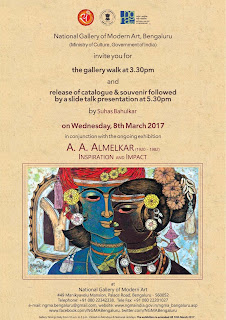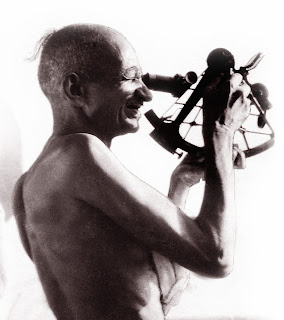Birth Centenary of Abdul Rahim Appabhai Almelkar : A Tribute.
Images : Courtesy NGMA, Mumbai.
This day, 10th October, 2020, marks the birth centenary of Abdul Rahim Appabhai Almelkar (10th October1920 - 12th December 1982), a well known artist known for his own distinct ‘Almelkar style’, which was inspired by Indian miniatures. The NGMA, Mumbai has an outstanding collections of Almelkar. Of the 1456 art collections, which NGMA Mumbai has in its collections, nearly 1200 of the works are that of Almelkar. It was therefore no wonder that the NGMA, Mumbai, developed a major retrospective exhibition of Almelkar titled ‘AA Almelkar : Inspiration and Impact‘. This exhibition was curated by Shri Suhas Bahulkar. I had the honour to be the Director of NGMA, Mumbai when this exhibition was planned, curated and hosted at NGMA Mumbai and subsequently at NGMA Bangalore.
Although Almelkar works formed major collections of NGMA, Mumbai, yet there was not a single well researched and curated exhibition of the works of Almelkar. Fortunately the then Advisory Committee of NGMA Mumbai, under the chairpersonship of Dr. Pheroza Godrej, rightfully decided and recommended that NGMA Mumbai must present a curated retrospective exhibition that is primarily centered on the collections of the works of Almelkar, from NGMA Mumbai collections. The recommendations of the committee provided a much needed impetus for planning this exhibition, abiding to all the rules and procedures that underpin the functioning of the NGMA and planning an art exhibitionM which befits the stature of the NGMA. The result was an exhibition which was titled ‘A A Almelkar: Inspiration and Impact’. This exhibition was very well researched and curated by Mr Suhas Bahulkar.
Almekar played an important role in the history of Indian Art. His style of paintings, which depicted rural and tribal life & culture, made his work distinctive and unique. Decorative elements dominated his works and made the compositions very diverse, innovative and ingenious. His works were influenced by the cultural ingredients prevalent in the Indian art world during the first half of the twentieth century. The use of texture and the synthetic graceful lines were the soul of his paintings. His works also reveal a simple unassuming art with brilliant rhythmic fluid lines, local colours, people and landscapes that were predominantly a visual documentation of western India.
Almelkar was obsessed by traditional values of Indian art and by Indian ethos, while the Progressive Artists Group, who were making a major mark on the Mumbai art scene, was challenging all forms of traditional art traditions in Mumbai. Almelkar started working vigorously on his Indian style and remained faithful to it all through his life. The experimental modernists from the Bombay Progressive Group, dismissed his style in derogatory terms and stated that ‘he recites the same old Raga’. Almelkar remained unfazed and never took their comments seriously. He had deep faith in the roots of Indian Art and truly believed in the traditional methods. He had no support for his style of art, yet he was confident to lead a lonely crusade against the well established artists who identified themselves as ‘Modernists’. It was a period when the art movement in India was divided in two major streams, one led by radical reformists, which included eminent artists like Souza, Husain, Raza and others from the Progressive group and the other explored by artists like Almelkar and few other the traditionalists.
Almelkar created his paintings by making a skillful use of luminous colours and decorative elements in a variety of compositions. Bahulkar, the curator of the exhibition, often said that Almelkar applied colours with his fingers instead of brush. Texture created by jute, comb and rags was the hallmark of Almelkar’s style. His paintings were completed after defining the contours with lyrical and tender black lines. Almelkar was known for his landscapes, which he painted with emotive colours. His paintings bear a signature of his attraction to Indian miniatures. His other works included, paintings based on kings and consorts, heroes and heroines and Raga-Raginis of the Hindustani music. Subsequently he spent a major part of his time in to studying the primitive world of adivasis, which he has depicted in most of his drawings that are in the collections of NGMA, Mumbai. He has painted Indian villages in their full diversity exhibiting their rich culture along with nature, birds and animals, which are a treat for the eyes.
He visited several tribal areas, forests, villages all across the western India, especially Rajasthan, Gujarat, Kutch, Maharashtra and the whole of the western costal line right up to Kerala, to make a visual documentation survey of people and their natural landscape. He remained largely untouched by the influence of his peer groups who were mostly impacted by the western world aesthetics, classics or subjects. He never followed any typical school of traditional art, though he had worked with different mediums such as oil on canvas, water color on paper, predominantly ink, and pencil line drawings on papers. Almelkar was majorly inspired by the Ajanta and Ellora Buddhist murals, frescos and sculptures. His works bear true signs of his perfect and minute observations, which can be witnessed in his paintings that depict plants, animals, birds, hills, mountains, rivers, towns, villages etc. There are very few artists who exhibit a particular signature style of art, as does Almelkar, and therefore the Almelkar retrospective exhibition at the National Gallery of Modern Art, Mumbai, was a befitting tribute to this truly deserving artist, who most unfortunately has not been given the due that he rightfully deserves.
Mr Suhas Bahulkar who was chosen by NGMA Mumbai to curate the retrospective exhibition of Almelkar, was well acquainted with Almelkar and he had also invited Almelkar for a demonstration at Sir. J.J. School of Art, while he served there as a teacher. Bahulkar’s personal association with the artist was vividly seen in the passion with which he was involved in this exhibition, which he titled ‘A. A. Almelkar - Inspiration and Impact’. The exhibition consisted majorly selection of sketches and paintings from the collection of NGMA, Mumbai. Bahulkar also collected a wide variety of archival materials that included photographs, original letters, articles and documents related to his works and exhibitions, which formed a part of the exhibition. The collections of the archival information was an outcome of an overwhelming response from Almelkar's intimate friends and their families from various places like Mumbai, Pune, Solapur, Nagpur etc. Almelkars family also extended a whole hearted support for the exhibition. The copious amount of archival material collected by Suhas Bahulkar was used in the well researchedM visually rich exhibition catalogue, which was published by NGMA Mumbai. The result was on expected line and the exhibition was a grand success. Interestingly enough Almelkar, who hails from the Solapur, which adjoins its area with its neighbouring districts of Bijapur and Gulbarga in Karnataka, is quite famous in Karnataka as well and therefore it was no wonder that the then Chairman of the Advisory committee of NGMA Bangalore decided to host this exhibition in NGMA Bangalore, where too the exhibition was very successful.
Almelkar was a recipient of 20 Gold Medals, 24 Silver Medals and several cash awards. He had organised 44 exhibitions in India and abroad. On the occasion of his birth centenary, I take this opportunity to pay my tribute to this great artist. May he continue to remain in the hearts and minds of people.





































